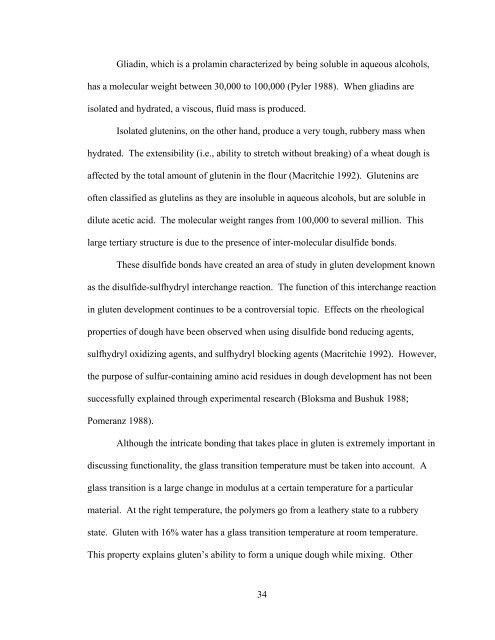EVALUATION OF FOUR SORGHUM HYBRIDS THROUGH THE ...
EVALUATION OF FOUR SORGHUM HYBRIDS THROUGH THE ...
EVALUATION OF FOUR SORGHUM HYBRIDS THROUGH THE ...
Create successful ePaper yourself
Turn your PDF publications into a flip-book with our unique Google optimized e-Paper software.
Gliadin, which is a prolamin characterized by being soluble in aqueous alcohols,<br />
has a molecular weight between 30,000 to 100,000 (Pyler 1988). When gliadins are<br />
isolated and hydrated, a viscous, fluid mass is produced.<br />
Isolated glutenins, on the other hand, produce a very tough, rubbery mass when<br />
hydrated. The extensibility (i.e., ability to stretch without breaking) of a wheat dough is<br />
affected by the total amount of glutenin in the flour (Macritchie 1992). Glutenins are<br />
often classified as glutelins as they are insoluble in aqueous alcohols, but are soluble in<br />
dilute acetic acid. The molecular weight ranges from 100,000 to several million. This<br />
large tertiary structure is due to the presence of inter-molecular disulfide bonds.<br />
These disulfide bonds have created an area of study in gluten development known<br />
as the disulfide-sulfhydryl interchange reaction. The function of this interchange reaction<br />
in gluten development continues to be a controversial topic. Effects on the rheological<br />
properties of dough have been observed when using disulfide bond reducing agents,<br />
sulfhydryl oxidizing agents, and sulfhydryl blocking agents (Macritchie 1992). However,<br />
the purpose of sulfur-containing amino acid residues in dough development has not been<br />
successfully explained through experimental research (Bloksma and Bushuk 1988;<br />
Pomeranz 1988).<br />
Although the intricate bonding that takes place in gluten is extremely important in<br />
discussing functionality, the glass transition temperature must be taken into account. A<br />
glass transition is a large change in modulus at a certain temperature for a particular<br />
material. At the right temperature, the polymers go from a leathery state to a rubbery<br />
state. Gluten with 16% water has a glass transition temperature at room temperature.<br />
This property explains gluten’s ability to form a unique dough while mixing. Other<br />
34

















